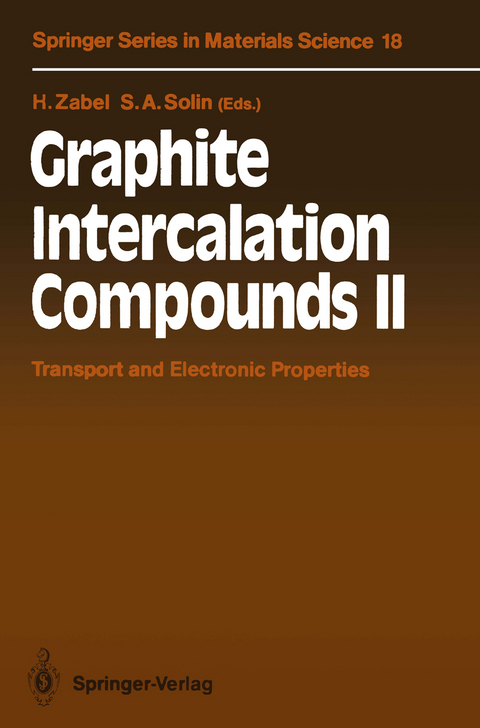
Graphite Intercalation Compounds II
Springer Berlin (Verlag)
978-3-642-84481-2 (ISBN)
The emphasis of this book, the companion volume to Volume 14 of the Springer Series Materials Science, is on the basic physics and materials science of graphite intercalation compounds arising from their quasi-two-dimensional structure. The various chapters are designed to guide graduate students and other newcomers into the exciting field of two-dimensional physics, and at the same time to provide a comprehensive review of the current status of the field.
1. Introduction.- References.- 2. Electronic Band Structure of Graphite Intercalation Compounds.- 2.1 Methods for Band Structure Calculations.- 2.2 Graphite.- 2.3 Electronic Band Structures of Low-Stage Graphite Intercalation Compounds.- 2.4 Electronic Band Structure of High-Stage Graphite Intercalation Compounds.- 2.5 Summary and Conclusions.- References.- 3. Electron Spectroscopy of Graphite Intercalation Compounds.- 3.1 Essential Concepts.- 3.2 The Situation in the Literature.- 3.3 Principal Results for the Electronic Structure.- 3.4 Photoemission from Acceptor GICs.- 3.5 Summary and Conclusions.- References.- 4. Effects of Charge Transfer on the Optical Properties of Graphite Intercalation Compounds.- 4.1 Experimental Considerations.- 4.2 Deducing Charge Transfer from Optical Studies.- 4.3 Experimental Results and Discussion.- 4.4 Summary and Conclusion.- References.- 5. Superconductivity of Graphite Intercalation Compounds.- 5.1 Superconductivity of C8M (M= K, Rb, Cs).- 5.2 Superconductivity of Binary Intercalants.- 5.3 Theoretical Aspects of the Origin of Superconductivity in GICs.- References.- 6. Transport Properties of Metal Chloride Acceptor Graphite Intercalation Compounds.- 6.1 The In-Plane Electrical Resistivity.- 6.2 The In-Plane Thermal Conductivity.- 6.3 The In-Plane Thermoelectric Power.- 6.4 c Axis Transport and Anisotropy.- 6.5 Transport in Magnetic GICs.- 6.6 Concluding Remarks.- References.- 7. Magnetic Intercalation Compounds of Graphite.- 7.1 Background.- 7.2 Origin of Magnetic Interactions.- 7.3 Experimental Techniques for Studying GICs.- 7.4 Overview of Magnetic GICs.- 7.5 Summary.- References.- 8. Intercalation of Graphite Fibers.- 8.1 Precursor Graphite Fibers.- 8.2 Intercalation.- 8.3 Structure and Staging.- 8.4 Raman Characterization.- 8.5 Transport Properties.- 8.6 Mechanical Properties.- 8.7 Thermal Expansion.- 8.8 Applications of Intercalated Carbon Fibers.- 8.9. Summary and Conclusions.- References.
| Erscheint lt. Verlag | 16.12.2011 |
|---|---|
| Reihe/Serie | Springer Series in Materials Science |
| Co-Autor | G.L. Doll, G. Dresselhaus, M.S. Dresselhaus, P.C. Eklund, M. Endo, N.A.W. Holzwarth, J.-P. Issi, J.T. Nicholls, R. Schlögl, Stuart A. Solin, S. Tanuma, Hartmut Zabel |
| Zusatzinfo | XIV, 433 p. |
| Verlagsort | Berlin |
| Sprache | englisch |
| Maße | 155 x 235 mm |
| Gewicht | 669 g |
| Themenwelt | Naturwissenschaften ► Physik / Astronomie ► Atom- / Kern- / Molekularphysik |
| Naturwissenschaften ► Physik / Astronomie ► Festkörperphysik | |
| Technik ► Maschinenbau | |
| Schlagworte | band structure • graphite intercalation compounds • Magnetic properties • optical properties • phase transition • phase transitions • Physics • Science • Superconductivity • Transport |
| ISBN-10 | 3-642-84481-2 / 3642844812 |
| ISBN-13 | 978-3-642-84481-2 / 9783642844812 |
| Zustand | Neuware |
| Haben Sie eine Frage zum Produkt? |
aus dem Bereich


